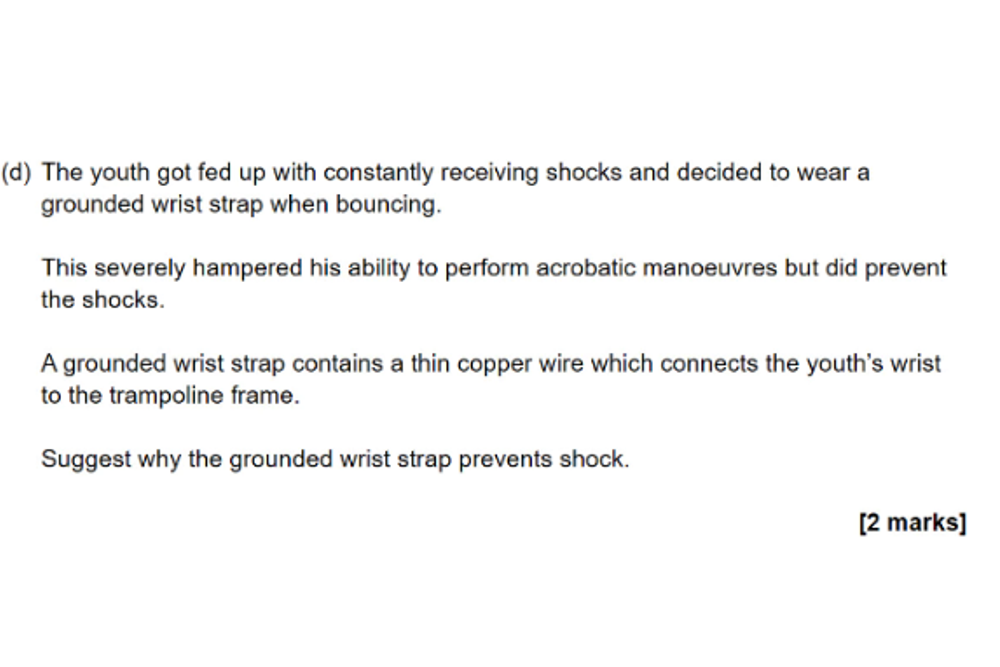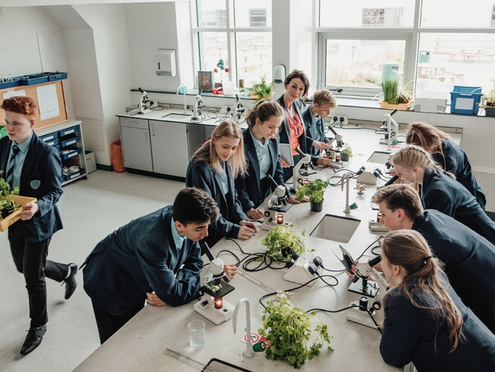What is disciplinary literacy in science?
Vocabulary instruction is not just the domain of the English classroom; words matter in every subject across the curriculum. This is especially true of subjects with a large amount of essential subject-specific terminology, such as Biology, Physics and Chemistry.
A strong understanding of vocabulary, not just of the Tier 3 vocabulary of science subjects but of Tier 2 context-specific definitions, helps your learners construct better essay responses, better understand newly taught content, and communicate like experts in any given discipline.
Learn more about the vocabulary tiers and what they mean in our full article.
Despite the importance of explicit vocabulary instruction, some teachers of STEM subjects still rely on learners to pick up new vocabulary incidentally, or use word lists and textbooks to introduce new terminology. This is not enough to achieve mastery of new terminology.
Research has shown that it takes 5-8 high-quality encounters with new vocabulary before the terms are embedded and mastered, and this requires dual-coding and teaching vocabulary in context. To ensure that every learner in the classroom has the vocabulary knowledge they need to thrive, both when learning new content and when tackling challenging exam questions, subject-specific vocabulary must be explicitly taught in every discipline.
Why is disciplinary literacy in science important?
Take this example question from a GCSE Science paper (2018 AQA Physics, Static Electricity):

Aside from the necessary subject knowledge learners need to know, this question assumes the learner understands the words “severely”, “hampered”, “manoeuvres”, and even words that might seem simple to some - “perform”, “prevent”, “constantly” - but which could be completely unknown to learners who are less proficient at reading.
This illustrates that not only do learners need to know the Tier 3 vocabulary of their subject - “shock” - but also the subject-specific connotations of words they might know as having another definition - “grounded”. This is all facilitated by prior knowledge of the Tier 2 words that form the question. For a learner to have the best opportunity to answer this question, they need three different types of explicit vocabulary instruction; all are necessary for success in Science.
The reading age of a GCSE paper has been calculated at 15 years and 7 months, but one in three learners do not have this reading age by the time they sit their exams. Teachers of every subject are responsible for explicit vocabulary instruction to ensure every learner has the opportunity to succeed in their exams - and their wider lives!
Research has shown that the vocabulary gap that forms between learners from advantaged backgrounds and learners from disadvantaged backgrounds is in place by the time they are four years old. For every year a learner spends in education with this literacy gap unaddressed, the gap widens and becomes increasingly difficult to close.
Ensuring learners understand the vocabulary of their science papers is one small step to closing that gap, but a crucial step all the same.
The negative effect of teacher jargon and scientific terms on student comprehension
Once you become highly knowledgeable and skilled in an area, it can be difficult to visualise the steps you took to acquire the knowledge you now have. Teachers are challenged every lesson to put themselves in the position of their learners and strategise new ways to convey knowledge.
For the most part, teachers are excellent at achieving this and equipping learners with the content they need in accessible ways. However, one area where this is especially difficult is knowing which academic vocabulary to teach explicitly.
It can be tricky for subject experts to remember which vocabulary they learned incidentally and which was explicitly taught. Scientific jargon that is second nature to science teachers can form a barrier, holding learners back from comprehension - for example, almost every science teacher will teach the Tier 3 term “titration” to their learners, but perhaps not teach the scientific term for a “pipette” or a “chemical reaction”, terms some learners will have understood contextually but for other learners create gaps in their understanding of the topic as a whole.
To ensure that every learner in your class enters the exam hall - or maybe a career in science - with the Tier 2 and Tier 3 vocabulary they are required to know, teachers must teach the subject-specific vocabulary of their discipline explicitly.
Subject-specific vocabulary definitions can cause confusion
The most common examples of subject-specific definitions are found in the academic vocabulary of many exam questions - “explain”, “describe”, “evaluate” and “analyse”. While in Religious Studies or Psychology, “evaluate” encourages learners to explore the benefits and drawbacks of a theory and determine its effectiveness, in Maths “evaluate” encourages learners to find the numerical value of a sum or formula.
There are many terms used in science that have different meanings in other contexts - for example, a “solution” in Maths is the answer to a problem, while in Chemistry it is a mixture of two chemicals. In order to ensure learners have the vocabulary necessary to understand new scientific concepts, teachers should predict which words have unique definitions in science versus other subjects; this can be a time-consuming and subjective process without the help of a Tier 2 and 3 subject-specific vocabulary strategy.
The memorisation of terminology is not the best way to improve scientific vocabulary
Once you have determined the Tier 2 and 3 subject-specific vocabulary your learners need to know, it’s a matter of how to go about ensuring it is mastered. For some teachers, this process involves writing keyword lists on the whiteboard, handing out terminology lists or relying on textbooks to address the vocabulary gaps.
Research suggests that it takes 6-8 high-quality, dual-coded encounters with ambitious vocabulary to ensure it is retained and mastered. Learners should be able to define new vocabulary in their own words, link it to prior knowledge, understand synonyms and antonyms, and ultimately demonstrate they are able to use the word naturally in a piece of writing. Handing out a word list, while an important first step, does not ensure every learner has a deep understanding of necessary terminology.
But supporting every student to achieve mastery is a time-consuming process. Individuals are likely to struggle with different words and have different levels of confidence with new terminology. Especially in content-loaded subjects like Biology, Physics and Chemistry, balancing the personalisation of vocabulary instruction with teaching content can be difficult to achieve without support from a whole-school vocabulary strategy or digital vocabulary tool.
To ensure every learner achieves mastery of the Tier 2 and Tier 3 vocabulary they need to succeed in science, teachers must craft a consistent strategy as part of a wider focus on disciplinary literacy.
Teaching learners to think, read and write like scientists
The ultimate goal when aiming for the mastery of subject-specific terminology in science is equipping learners with the skills to think, read and write like scientists. Learners do not just memorise content and regurgitate it in exam settings - they truly understand scientific content and can apply it to a variety of situations. If prior knowledge of content and subject-specific vocabulary is secure, learners have the understanding and the keywords they need to approach any exam question.
More than just exams, learners can use their ability to think, read and write like scientists in their wider life. This opens doors for higher education studying the sciences, as well as careers in science.
Specific demographics of students are less likely to pursue careers in STEM, such as girls and learners from disadvantaged backgrounds. In the case of the latter demographic, this group is also less likely to have acquired a strong understanding of subject-specific vocabulary incidentally, meaning that without explicit vocabulary instruction they are the most likely to be left behind in the classroom.
When subject-specific vocabulary instruction unlocks learners’ ability to approach science like experts, learners feel they have the potential to succeed in science, removing some of the barriers to careers in STEM.

Encourage every learner to communicate like an expert
Create a broad, deep, curriculum that refines learners’ subject knowledge and improves educational outcomes across all subjects.
Examples of subject-specific terminology in the sciences
Biology
Tier 3: Chloroplast, mitosis, aorta, chlorophyll, nucleus, chromosome, aorta, phloem, pulmonary, xylem, transpiration, osmosis, antibiotic, vaccine, respiration, glucagon, receptor, stimuli, diabetes, binomial, DNA, ribosome
Tier 2: Solution, variation, competition, community, population, transport, concentration, evidence, constant, sketch, rejection
Some of the Tier 2 words featured in the Biology curriculum and exam papers have unique definitions in other disciplines, such as “solution” in Maths, “community” in Geography, “evidence” in History and “sketch” in Art. For this reason, even though these words are not that challenging in and of themselves, misconceptions can be avoided by including them in your explicit vocabulary instruction.
Physics
Tier 3: Joule, watt, amperes, diode, coulomb, ohms, thermistor, volt, condensation, pascals, sublimation, alpha, beta, gamma, becquerel, radiation, fission, isotope, proton, neutron, acceleration, inertia, velocity, hertz, convex, microwave, ultraviolet
Tier 2: Attraction, decay, efficiency, power, parallel, pressure, force, weight, waves, component, potential, unit, generate, insulate, capacity
Many of the Tier 2 words in Physics have subject-specific definitions in other subjects, such as “parallel” in Maths, “component” in Design Technology, “attraction” in Psychology and “power” in Physical Education.
Chemistry
Tier 3: Electron, alkali, distillation, filtration, neutron, halogen, covalent, ionic, intermolecular, lattice, polymer, nanoscience, cathode, oxidation, titration, exothermic, endothermic, catalyst, alkene, alkane, carboxylic, esters, litmus, alloy, bioleaching
Tier 2: Resource, sustainable, substance, cracking, combustion, pressure, collision, activate, indicate, uncertainty, conservation, mixture, compound, reaction, balance, decompose, yield, extract
How to teach subject-specific vocabulary in science lessons
The process of exposing learners to new terminology through high-quality encounters can be broken down into six steps. These steps can be used to teach the vocabulary wholly or to support learning your students complete on Bedrock, linking their Mapper sessions to their classroom activities.

Teach Disciplinary Literacy with Bedrock Mapper
Encourage every learner to communicate like an expert in every subject across the curriculum. Sign up to demo the Bedrock app for free.
Step 1. Explain
The definitions of new terminology should be explained in language learners are familiar with - if possible, accessible Tier 1 vocabulary. As well as this, context should be provided through sentences and examples from life, if applicable.
Step 2. Reinstate
In pairs, encourage learners to explain to each other what the new terminology means in their own words and create their own examples. Teachers can wander around the room and listen in to the definitions learners are giving, both to identify misconceptions and also to level up responses.
Step 3. Show
Ask learners to draw a picture, symbol, graphic or knowledge organiser displaying the concept they have learned. This provides an easy way for you to see the way they visualise the concept, allowing you to address misunderstandings, while also helping them acquire another high-quality encounter with the word.
Step 4. Discuss
Facilitate a structured conversation to discuss the new word, such as prompting learners to think of synonyms and antonyms, or modelling examples of how to use the word in a conversation. Not only does this deepen their understanding of the term, but it also improves their oracy, encouraging them to use the high-level vocabulary of their lessons in day-to-day conversation.
Step 5. Refine and reflect
Ask learners to return to the first definition they wrote in an exercise book (Step 2). Is there anything they want to change?
By encouraging learners to correct their own misconceptions, you encourage them to learn independently, boosting their confidence when encountering unknown terminology in the future. In order for learners to read, write and think like experts, teachers should encourage them to process new information and terminology independently, as an expert would.
Step 6. Play!
An often underrated step, play is a powerful method for embedding new knowledge. Vocabulary games such as Charades, Taboo, Bullseye, Jeopardy and more can help learners think intuitively about new vocabulary. These games also help learners connect new terminology to prior knowledge, fleshing out their overall understanding of high-level vocabulary and concepts.
How Bedrock Mapper supports disciplinary literacy in science
As mentioned earlier, crafting a Tier 2 and 3 subject-specific vocabulary strategy for your whole class can be a time-consuming task. As well as this, it’s unlikely any teacher would have the time to personalise their vocabulary instruction to each individual learner while also teaching the breadth of content on the science curriculum - if you can, we applaud you!
For most science teachers, personalising learners’ vocabulary curricula is only possible with the help of educational technology tools - and the only one suited to providing a bespoke subject-specific vocabulary curriculum for teachers in STEM is Bedrock Mapper.
Bedrock Mapper allows teachers to map their own bespoke vocabulary curriculum for their subject. Teachers from every discipline across the school can make their vocabulary curriculum, as well as observe learners completing sessions across subjects. This allows learners to understand the subject-specific definitions and contexts of certain words.
To save teachers time, Bedrock Mapper is rich with Bedrock-created content that can be added to your bespoke curriculum at the click of a button. Your vocabulary curriculum can be as personalised or as instantaneous as fits your schedule and can be planned to fit alongside learning in the classroom.
With Bedrock Mapper, every teacher is given back the time they need to construct a consistent vocabulary curriculum across each discipline, promoting whole-school literacy. Teachers in every subject will reap the benefits of this!
On average, learners on Bedrock Mapper make over 30% progress from the pre-test to the post-test, with the lowest prior achieving learners making over 700% progress. This shows that Bedrock Mapper not only has the potential to teach subject-specific vocabulary definitions but also to close language gaps, giving learners of all abilities and backgrounds an even playing field.
As well as Bedrock Mapper, Bedrock’s core curriculum (featuring Tier 2 vocabulary and grammar instruction) can be beneficial for learners’ progress in every subject, as learners are better able to convey the content they know through ambitious words and accurate grammar. As learners progress through the key stages, the accuracy of their spelling, grammar and punctuation becomes increasingly important, and may even make the dividing mark between two grades.
Sign up for your free trial of Bedrock’s core curriculum and Mapper tool.



